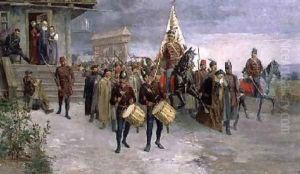Nagy Lazar Paintings
Nagy László, known internationally as László Nagy, was a Hungarian painter and graphic artist born on 26 August 1893 in Szeged, Hungary. He was a prominent figure in the Hungarian art scene during the 20th century, though not as well-known internationally as some of his contemporaries. Nagy's early work was influenced by the naturalism and academic painting traditions prevalent at the time, but he gradually shifted towards more modernist approaches as his career progressed.
After studying art in Budapest, Nagy later moved to Paris, which was then the epicenter of the art world. Here, he was exposed to the avant-garde movements of the early 20th century, such as Fauvism, Cubism, and Expressionism. These influences began to permeate his work, and he developed a distinctive style that combined elements of these movements with his own personal vision.
Throughout his career, Nagy exhibited his work widely, both in Hungary and internationally. He participated in numerous group exhibitions and had several solo shows, which helped to establish his reputation as a leading Hungarian modernist artist. His work often explored themes of human existence, the natural world, and the spiritual or mystical dimensions of life.
During World War II and the subsequent communist regime in Hungary, Nagy, like many artists of his time, faced challenges in terms of artistic freedom and expression. Nevertheless, he continued to create and adapt, often working within the constraints imposed by the political climate of his country.
Nagy's contributions to Hungarian art were recognized with various awards and honors throughout his lifetime. His works are part of several museum collections and continue to be appreciated by art historians and collectors.
László Nagy passed away on 11 April 1983 in Budapest, leaving behind a rich legacy of artistic work that continues to inspire and influence Hungarian art to this day. His dedication to exploring new artistic directions while remaining connected to his cultural roots is seen as a testament to his innovative spirit and his commitment to the artistic vocation.
